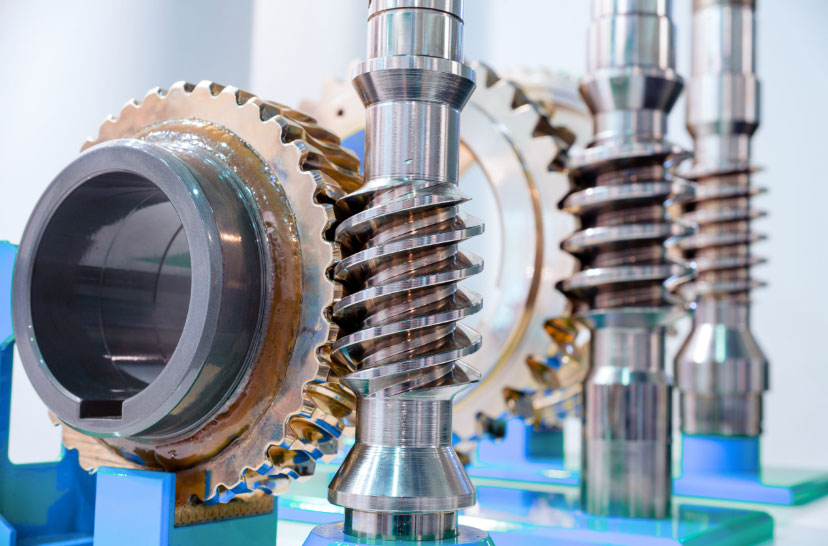
This paper presents an innovative dual-segment anti-backlash worm gear system designed for optical turrets in Mars exploration missions. Addressing challenges including extreme temperature fluctuations (-95°C to 70°C), mass constraints (total weight < 130g), and zero-backlash requirements (positioning error < 0.01°), the proposed worm gear system achieves an 80:1 reduction ratio with 33.8% transmission efficiency while maintaining 10.62mN·m starting torque.
1. Structural Design Principles
The dual-segment worm gear configuration eliminates backlash through axial preloading, featuring:
- Two-piece titanium alloy worm shaft with polyimide worm wheel
- Adjustable shim (thickness: 0.5±0.003mm) for thermal compensation
- Spring-loaded preload mechanism (10N force)
The contact stress distribution follows:
$$ \sigma_H = Z_E \sqrt{\frac{F_t}{d_1 b} \cdot \frac{u+1}{u}} $$
Where \( Z_E = 160 \sqrt{\text{MPa}} \) (material coefficient), \( F_t = 7.8\text{N} \) (tangential force), \( d_1 = 18\text{mm} \) (worm pitch diameter), \( b = 15\text{mm} \) (face width), and \( u = 80 \) (gear ratio).
2. Material Selection Analysis
| Material | Density (g/cm³) | Thermal Expansion (10⁻⁶/K) | Strength (MPa) |
|---|---|---|---|
| Polyimide YS20 | 1.48 | 3.0 | 130 |
| Ti-6Al-4V | 4.51 | 8.6 | 895 |
| Beryllium | 1.85 | 11.3 | 243 |
The polyimide-titanium combination reduces mass by 62% compared to steel alternatives while maintaining sufficient wear resistance through carbon-doped self-lubrication (\( \mu = 0.1-0.12 \)).
3. Worm Gear Parameter Optimization
| Parameter | Worm | Wheel |
|---|---|---|
| Module (mm) | 1.6 | 1.6 |
| Teeth Count | 1 | 80 |
| Pitch Diameter (mm) | 18 | 128 |
| Face Width (mm) | 15 | 35 |
Bending safety factors verify design robustness:
$$ S_F = \frac{\sigma_{FP}}{K_A K_V K_{mB} \sigma_t} = 15.6 $$
Where \( \sigma_{FP} = 42\text{MPa} \) (allowable bending stress), \( K_A = 1.25 \) (application factor), \( K_V = 1.1 \) (dynamic factor), and \( K_{mB} = 1.3 \) (load distribution factor).
4. Thermal Compensation Mechanism
The adjustable shim thickness compensates for differential thermal expansion:
$$ \Delta s = (\alpha_{\text{worm}} – \alpha_{\text{wheel}}) \cdot L \cdot \Delta T $$
With \( \alpha_{\text{worm}} = 8.6 \times 10^{-6}/\text{K} \), \( \alpha_{\text{wheel}} = 3.0 \times 10^{-6}/\text{K} \), \( L = 73\text{mm} \) (center distance), and \( \Delta T = 160\text{K} \) (operating range), the required shim adjustment is:
$$ \Delta s = (8.6 – 3.0) \times 10^{-6} \times 73 \times 160 = 0.065\text{mm} $$
5. Performance Validation
Environmental testing protocol:
| Test | Conditions | Duration |
|---|---|---|
| Thermal Cycling | -95°C ↔ +70°C, 6 cycles | 48h |
| Random Vibration | 14.1Grms, 3 axes | 3min/axis |
| Life Test | 0.5N·m @ 100rpm | 3×10⁵ cycles |
Post-test inspection showed:
- Tooth contact pattern maintained >80% coverage
- Backlash variation < 0.002mm
- Surface roughness Ra < 0.4μm
6. Conclusion
The dual-segment worm gear design successfully addresses Mars mission requirements through:
- Mass reduction via polymer-metal material pairing
- Thermally stable backlash compensation
- Vibration-resistant preload mechanism
This worm gear configuration enables precision pointing (<0.005° repeatability) for optical payloads while withstanding Martian environmental extremes, demonstrating viability for future deep space applications.
